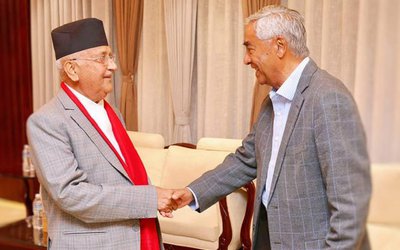Is normalcy returning to Nepal? I don’t mean normal as in perfect health, but normal as messy muddling along that we as a relaxed country are famous for. Used to fending for ourselves with the help of friends and family, we ask for modest delivery from the state and are happy with a token government necessary for that.
This happy-go-lucky state of affairs was shaken to its foundations in February 1996 when a bunch of professional Leninists claiming to adhere to Maoism opted for violence as the coercive tool to achieve political power. With that mass brutality, the customary smile disappeared from Nepali faces; people even stopped greeting each other on village trails; and the saying “atithi devo bhava” (“a guest is god”) became “atithi rakshyash bhava” or “guests are uninvited, terrorizing insurgents who will loot whatever food there is in the house”! A miasma of distrust shrouded the land, and under its cover, a social wrenching ensued with carpetbaggers, merchants of death, and opportunists of every shade making hay while good people were cowered into silence.
Now, maybe, just maybe, people seem to be standing up and asserting themselves, questioning the official party propaganda of progress, the fake triumphalism of Nepal’s lost decades. Last Saturday in Patan’s Jhamel, even as Patan’s patron deity Matsyendranath was being towed as per ancient ritual, a Nepali novel was publicly released. The book, Kopila Ashram is by Dr. Raamesh Koirala, a Ukrainian Lvov-trained cardiac surgeon at Gangalal hospital. He manages to pull off a difficult genre of realism, writing about the controversial topic of child trafficking, setting it within a very contemporary context. In the process, keeping the suspense right to the end, he forces the reader to reflect on the dark side many would prefer to keep under the carpet. If nothing else, the author needs to be commended for focusing ultraviolet and x-ray beams on a dark pus-filled gangrene within Nepali society, a sad byproduct of the insurgency.
In talking about the book, it would be highly improper for me to say, “The butler did it!” and ruin the fun for the reader. The great suspense director, Alfred Hitchcock was once pestered by a reporter for an interview. Unable to shake him off, Hitchcock met him and immediately began describing the kind of suspense movie he was thinking of making. Salivating at the prospect of a breaking-news story, the reporter listened in rapt attention as Hitchcock described the scene of an opera house where, just as the soprano was hitting the high pitch finale, a murder took place in balcony and the dead body fell onto the main hall. In the pandemonium, the soprano fainted and was carried backstage, where a sprinkle of cold water revived her. She asked to be left alone, and when the door closed, she picked up the phone and dialed a number…
The reporter asked, “And then…”
“I don’t know,” said the great Hitchcock and ended the interview.
In short, as the philosopher Schopenhauer says, one should treat a work of art like a prince – let it speak to you first. Kopila Ashram spoke to me, and these are some of the thoughts that went through my mind after reading it.
The book is brutal realism, but thankfully not the socialist realism of our vulgar Marxist “progressive” writers that plagues the Nepali literary scene, that being nothing but Stalinist coercion of artists forced to become propagandists for the communist party line. Realism of the second half of the 19th Century countered the romanticism of the previous half, which itself was a revolt against the rational excesses of the Industrial and French Revolutions. Socialist realism, on the other hand, was a degenerate Stalinist enterprise that strangely survives in under-developed and non-industrialized societies such as Nepal and India and is best captured in a Soviet-era joke. A painting of a drunk on a Moscow street labeled as such would be bourgeois art. However, if it was titled “A drunk on a Moscow street before the Great October Socialist Revolution” it would be highly commendable art of socialist realism, such evils having vanished after the Red Sun of Bolshevism shone on the land! Kopila Ashram, unlike much Nepali writing, does not moralize for a “progressive” cause but lays bare a dirty secret and forces the reader to confront it.
Conflict-ridden societies have produced heart-wrenching great literature. One can name the entire spectrum from Tolstoy’s War and Peace based on the Napoleonic wars in early 19th Century Russia to Khaled Hosseini’s The Kite Runner set against war-torn Afghanistan of the late 20th Century. After a series of vapid, socialist realism filled “dwanda sahitya” that a normal reader finds impossible to continue reading beyond a couple dozen pages unless one is a party true believer, Kopila Ashram comes as a refreshing relief to Nepali readers. The author must be thanked for ensuring that Nepal joins this global club, howsoever tentatively and modestly, opening more possibilities for him and other future writers exploring this genre.
I doubt if Dr Koirala has ever read Schopenhauer, the great 19th Century German philosopher who serves as the only main bridge between Western and Eastern philosophies; but if he did, he might have found himself as struck and influenced as Tolstoy was before he wrote Anna Karenina, or Thomas Hardy before he wrote Jude the Obscure and Tess of d’Urbervilles, or Wagner before he composed his Ring trilogy, or Emile Zola, Maupassant, Proust, Turgenev, Dylan Thomas… Schopenhauer’s philosophy of art tells us that such a genuine work allows us to escape temporarily from the relentless willing of Ichhya Shakti in the whirlpool of Maya, and provides us a temporary access to the eternal essence of the Platonic Form (“Para Vak” in Eastern philosophy). Such a work is also beyond Space and Time: indeed, every time I re-read War and Peace, characterizations such as Prince Vassily mentally refusing to use his influence to help poor Countess Drubetskaya, leap at me as if they were a Nepali bureaucrat promising but refusing to use his “source-force” for some poor supplicant.
Schopenhauer also considers the theme of tragedy the highest platform to base a work of art since it is only there that the unending conflict of will against itself is manifest in the phenomenal world and is the source of all suffering. This is where an artist comes face-to-face with the tragedy of clashing purposes and the purposelessness of chance in the lives of people great and small. This is where the eternal essence breaks through the humdrum of the temporary and mundane to reveal, even if briefly, the Kantian “thing-in-itself”. In weaving the tragedy of his many characters in Kopila Ashram, Koirala manages to provide the reader a feel for what has been the tragedy of Nepal, the lost individual lives and wasted two decades of the country’s life as the 20th Century slipped into the 21st. Read it for yourself and see how it speaks to you.

Dipak Gyawali
Gyawali is Pragya (Academician) of the Nepal Academy of Science and Technology (NAST) and former minister of water resources.
- Re-Thinking Democracy: Why South Asians Are worried
- Mar 17, 2025
- Nepal’s Governance Mired In Endemic Corruption
- Feb 20, 2025
- What Might The Age Of Trump Look Like?
- Jan 22, 2025
- Kathmandu Dialogue With Dugin
- Dec 25, 2024
- Bioregionalism Satsang
- Sep 27, 2024














